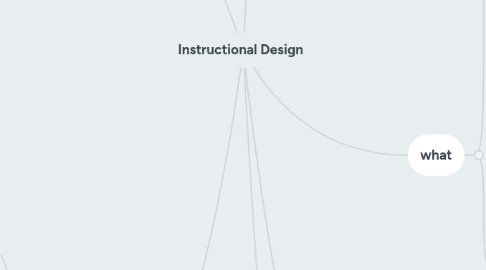
1. where
1.1. online
1.2. offline
1.3. blended learning
2. how
2.1. ADDIE
2.1.1. Analysis
2.1.1.1. the target audience
2.1.1.2. identify learning goals
2.1.1.3. time and place flexibility
2.1.1.4. course length
2.1.1.5. learning mediums
2.1.1.6. technical requirements
2.1.1.7. accessibility
2.1.1.8. methodology
2.1.2. Design
2.1.2.1. type of format
2.1.2.2. the use of learning material
2.1.2.3. developing education strategy
2.1.2.4. evaluating results
2.1.3. Development
2.1.3.1. demonstrate the general concept of the course
2.1.3.2. quality assurance
2.1.3.3. focus on content
2.1.3.4. run tests
2.1.4. Implementation
2.1.4.1. preparing the learners
2.1.4.2. instructors are prepared with good understanding of the course
2.1.4.3. preparing the environment
2.1.5. Evaluation
2.1.5.1. types of evaluation
2.1.5.2. the quality of the learning materials
2.1.5.3. correct past mistakes and improve the training
2.2. tools
2.2.1. internet
2.2.2. online forum
2.2.3. blogs
2.2.4. databases
2.2.5. library online
2.2.6. other web resources
3. who
3.1. designer
3.1.1. trainers/educators/course developers
3.2. learner
3.2.1. targeted groups
4. what
4.1. definition
4.1.1. a systematic process based on educational theories on the development of instructional strategies and specifications to promote quality learning outcomes
4.1.2. the knowledge on how people learn, the available tools, how to apply those tools and to engineer a plan to enhance teaching and learning experience.
4.2. models
4.2.1. Gagne
4.2.2. ADDIE
4.2.2.1. Analysis - analyse the instructional goals, target audience and required resources
4.2.2.2. Design - design a learning solution that aligns objectives and strategies with instructional goals
4.2.2.3. Development - develop learning resources, validate and revise drafts and conduct a test
4.2.2.4. Implementation - implement the learning solution by preparing learning spaces and engaging participants
4.2.2.5. Evaluation - evaluate the quality of learning resources and how well they accomplish the instructional goals
4.2.3. ROPES
4.2.3.1. Review and relate > Overview > Present and practice > Exercise > Summarize
